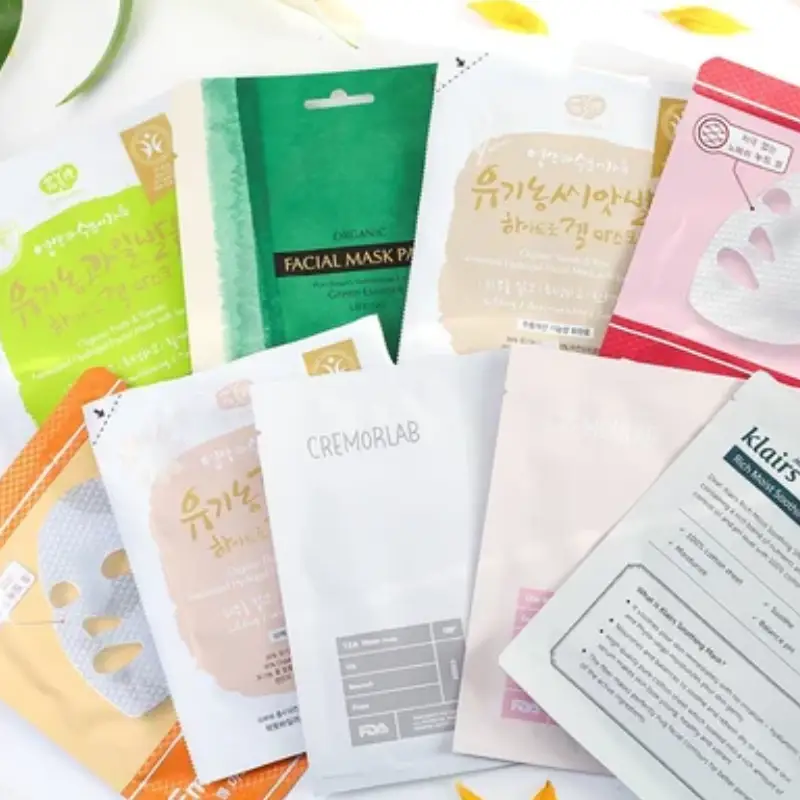Proper face mask packaging is essential for maintaining hygiene and ensuring product integrity. It protects masks from contamination, dust, and moisture, preserving their effectiveness until use. Effective packaging also plays a crucial role in branding and consumer trust, conveying professionalism and quality.
This blog post will guide you through the key considerations for packaging face masks, from material selection to design and labeling. We’ll explore best practices for both individual and bulk packaging, ensuring your masks are presented safely and attractively.
What is Facial Mask
A facial mask, in the skincare, is a topical treatment applied to the face to deliver concentrated ingredients and address specific skin concerns. These masks are formulated with various substances, such as clays, gels, creams, or sheet materials, and are designed to be left on the skin for a designated period before being removed. They provide a temporary boost to the skin’s condition, offering benefits like hydration, exfoliation, purification, or calming effects.
Facial masks cater to a wide range of skin types and issues, from dryness and acne to aging and dullness. They work by creating a barrier on the skin’s surface, enhancing the absorption of active ingredients and promoting relaxation. Regular use of facial masks can contribute to improved skin texture, tone, and overall appearance, making them a popular component of skincare routines.
How to Package Face Masks
Recommended Face Mask Packaging
Proper face mask packaging is vital for hygiene and safety. This guide outlines the essential steps to ensure your masks are packaged effectively, from preparation to final checks, maintaining product integrity.
Step 1. Preparation and Hygiene
Begin by ensuring a clean and sanitized workspace. Use gloves and sanitize all surfaces to prevent contamination. This is crucial for maintaining the hygiene of the face masks. Organize your packaging materials and face masks in a way that minimizes handling and exposure.
Inspect each face mask for any defects or damage before packaging. This step ensures that only high-quality masks are distributed to consumers. Discard any masks that do not meet quality standards. Maintain strict hygiene protocols throughout the packaging process to ensure product safety.
Prepare your packaging materials, including pouches, boxes, or bags, ensuring they are clean and ready for use. Select packaging that provides an adequate barrier against moisture and contaminants. Proper preparation streamlines the packaging process and maintains product integrity.
Step 2. Sealing and Packaging
Carefully place each face mask into its designated packaging, ensuring it is properly folded or arranged. For single-use masks, individual pouches are ideal. For bulk packaging, consider using resealable bags or boxes. Seal the packaging immediately to prevent exposure.
Use a heat sealer or appropriate sealing method to create an airtight seal. This prevents contaminants from entering and maintains the mask’s hygiene. Ensure the seal is strong and consistent to avoid any breaches. Perform quality checks on sealed packages to ensure integrity.
For multi-packs or retail displays, arrange the packaged masks neatly in boxes or display cases. Ensure the packaging is visually appealing and informative. Include clear labeling with usage instructions and safety information. Properly sealed and packaged masks are ready for distribution.
Step 3. Labeling and Final Checks
Apply clear and informative labels to each package, including the mask type, material, and usage instructions. Include any necessary safety warnings or certifications. Labeling should be legible and comply with relevant regulations. Double-check all labels for accuracy and completeness.
Conduct a final quality check of the packaged masks to ensure they meet all standards. Verify the sealing, labeling, and overall appearance of each package. Remove any damaged or improperly packaged masks. Maintain detailed records of the packaging process for quality control.
Prepare the packaged masks for storage or distribution. Store them in a clean, dry environment away from direct sunlight and contaminants. Ensure proper inventory management to track stock levels and expiration dates. Efficient storage and distribution are essential for maintaining product quality.
Packaging for Skincare Face Masks

Packaging for skincare face masks is crucial for preserving product efficacy, ensuring hygiene, and attracting consumers. Here are key considerations for you to choose skincare face mask packaging:
1. Material Selection:
- Barrier Properties: The packaging must protect the mask from moisture, air, and light, which can degrade active ingredients. Foil laminates, high-barrier plastics, and glass are commonly used.
- Compatibility: The material should be compatible with the mask formulation to prevent reactions or leaching of chemicals.
- Sustainability: Increasingly, brands are opting for recyclable, biodegradable, or PCR (post-consumer recycled) materials to appeal to eco-conscious consumers.
2. Packaging Formats:
- Single-Use Pouches: These are popular for sheet masks and single-application creams or gels. They offer convenience and maintain product freshness.
- Tubes: Ideal for cream or gel masks, tubes allow for precise dispensing and prevent contamination.
- Jars: Used for thicker masks like clay or mud masks, jars provide a classic and luxurious feel.
- Bottles: For liquid or serum-based masks, bottles with pumps or droppers offer easy application and portion control.
- Multi-Chamber Pouches: For masks that require mixing two components immediately before use, these pouches keep ingredients separate until needed.
3. Design and Labeling:
- Aesthetics: The packaging design should reflect the brand’s image and appeal to the target audience. High-quality printing, embossing, and special finishes can enhance perceived value.
- Information: Clear and concise labeling is essential, including ingredients, usage instructions, expiration dates, and any relevant warnings.
- Tamper Evidence: Sealing mechanisms or tamper-evident labels ensure product integrity and consumer safety.
4. Hygiene and Safety:
- Sterilization: For medical-grade masks or masks containing sensitive ingredients, sterilization may be necessary.
- Airtight Seals: Proper sealing prevents contamination and maintains product freshness.
- Easy Dispensing: Packaging should allow for hygienic and mess-free application.
5. Consumer Convenience:
- Portability: Single-use pouches and travel-sized containers are convenient for on-the-go use.
- Resealability: For multi-use products, resealable closures prevent drying and contamination.
- Ease of Use: Packaging should be easy to open, dispense, and dispose of.
Do Packaged Face Masks Expire
Yes, packaged face masks can expire, although the “expiration” may refer to different aspects depending on the mask type.
For disposable masks, such as surgical masks or N95 respirators, the primary concern is the degradation of the filter material and elastic straps over time. The filter’s electrostatic charge, which aids in particle capture, can diminish, and the elastic can lose its elasticity, compromising the mask’s fit and effectiveness.
Cloth masks, while reusable, also have a limited lifespan. Repeated washing and wear can cause the fabric to deteriorate, reducing its filtration efficiency. Additionally, any antimicrobial treatments applied to the fabric may lose their effectiveness over time. Therefore, while cloth masks don’t have a specific “expiration date” like disposable masks, they should be replaced when signs of wear become apparent or if they no longer fit snugly.
How to Choose Face Mask Packaging Properly
Choosing the right face mask packaging is essential for maintaining hygiene, ensuring product integrity, and appealing to consumers. Here are five crucial points to consider:
Barrier Protection and Hygiene:
Prioritize packaging materials that offer a strong barrier against moisture, dust, and contaminants. High-barrier films or laminates are ideal for preventing degradation of the mask material and maintaining sterility. Airtight seals are crucial to ensure that the masks remain uncontaminated until use, particularly for medical-grade masks. This protects the end user from potential infection and maintains product efficacy.
Material Durability and Strength:
Select packaging that is robust enough to withstand transportation and handling without tearing or puncturing. Durable materials like thicker plastics or foil laminates prevent damage, ensuring the masks arrive in perfect condition. Packaging should also be resistant to temperature fluctuations and physical stress, especially during shipping and storage. This ensures the packaging maintains its integrity throughout the supply chain.
Consumer Convenience and Usability:
Consider packaging that is easy to open and reseal, especially for multi-packs or reusable masks. Features like tear notches, resealable zippers, or easy-peel seals enhance user experience. The packaging should also be designed for convenient storage and portability. Clear instructions on how to properly use and dispose of the masks should be included, improving consumer understanding and safety.
Sustainability and Eco-Friendliness:
Opt for packaging materials that are recyclable, biodegradable, or made from post-consumer recycled content. Consumers are increasingly environmentally conscious, and sustainable packaging can enhance brand reputation. Minimize the use of excessive packaging and choose materials that reduce environmental impact. Consider using mono-material packaging to enhance recyclability, and clearly communicate the environmental benefits to the consumer.
Branding and Visual Appeal:
Design packaging that reflects your brand’s identity and attracts consumer attention. High-quality printing, clear labeling, and attractive graphics are essential for creating a professional image. The packaging should clearly display product information, certifications, and safety standards. Consider using transparent windows to showcase the product while maintaining hygiene. A visually appealing design can significantly influence purchasing decisions.
Conclusion
In conclusion, effective face mask packaging is essential for maintaining product hygiene, ensuring consumer safety, and enhancing brand perception. The right packaging not only protects masks from contamination but also conveys professionalism and quality. Considerations like material selection, sealing methods, and clear labeling are crucial for optimal results. Adapting to consumer preferences for convenience and sustainability is also key.
As the demand for face masks continues, innovative packaging solutions are vital. Brands must prioritize packaging that is both functional and visually appealing, reflecting a commitment to health and safety. Clear communication of usage instructions and disposal guidelines further enhances consumer trust. Embracing sustainable materials and practices aligns with growing environmental consciousness.
Ready to elevate your face mask brand with custom packaging that ensures hygiene and showcases your brand’s commitment to quality? Get custom face mask bags from BN Pack today! We offer a range of customizable solutions designed to meet your specific needs and exceed consumer expectations.



